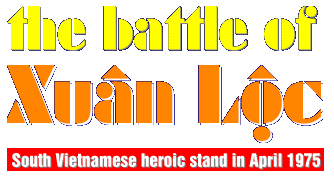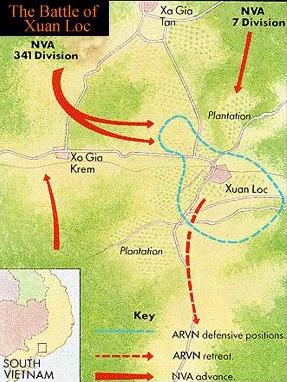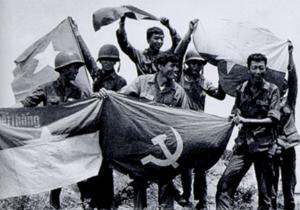
The ARVN forces defending Saigon were disposed to cover the five main roads leading into Saigon. North of Saigon, the 5th ARVN Division defended against an enemy attack down Highway 13. Northeast of the capital, the 18th ARVN Division held Xuan loc covering Highway 1 and the city and air base of Bien Hoạ Southeast of Saigon, two airborne brigades and a ranger group ( all at about 50 percent strength) defended against an enemy thrust up Highway 15. Southwest of Saigon, the reactivated and refitted 22nd ARVN Division sat astride Highway 4, the main route from the Mekong Delta to Saigon. Finally, in the northwest, the 25th ARVN Division held Route 1 between Tay Ninh and Saigon. These initial blocking positions were located some seventeen to thirty miles from the edges of Saigon. General Truong, who after his evacuation from Da Nang became deputy chief of the JGS in charge of Saigon's defense plans, saw that there could be no real defensive line around Saigon. The defensive circle was too large and the troop strength too meager. Yet to move the defensive circle closer to Saigon meant surrendering valuable real estate and huge cantonments (built by the American army) at Bien Hoa, Cu Chi, and Lai Khe, plus the principal ARVN logistic base at Long Binh, and the huge air base at Bien Hoạ Also, if the JGS brought the defensive lines too close to Saigon, it exposed the city to devastating artillery fire of the NVÁs 130mm guns.
And being North Vietnamese Communists, they had to have a plan for a Great Uprising in Saigon to accompany the Great Offensivẹ In spite of the fact that a plan for an uprising was totally unecessary, and that none of the uprisings planned for Tet 1968 or 1972 had remotely succeeded, the Communists drew up an elaborate plan for political "dau tranh" involving a "dich van" program among the South Vietnamese people and a "binh van" program (troop proselyting) aimed at the RVNAF. Before the Communist drive on Saigon could begin, the NVA had to undertake two preliminary operations - the seizure of Xuan Loc and the cutting of Highway 4. The Communists wanted to cut Highway 4 to prevent the movements of ARVN reinforcements from the Delta to Saigon and to secure a staging area for a later attack on the capital itself. Xuan Loc was a more significant NVA objectivẹ It anchored the eastern end of the outer defenses of Saigon. In ađition, the town controlled the roads from the east to Saigon, Bien Hoa, and Vung Tau, and covered the two big air bases at Bien Hoa and Tan Son Nhut. Both sides considered Xuan Loc to be the key to the defense of Saigon.
Neither of these preliminary operations went well. The NVA effort to cut Highway 4 sputtered and faltered, cutting Highway 4 and then being driven off by effective ARVN counterattacks. The battle for Xuan Loc produced one of the epic battles of any of the Indochina wars, certanily the most heroic ARVN stand in Indochina War IIỊ On 9 April, Dung attacked the 18th ARVN Division (reinforced) with the entire IV NVA Corps consisting of three infantry divisions (eventually reinforced to four) plus tanks and artillerỵ The fighting featured mass NVA infantry attacks supported by extremely heavy artillery fire (the ARVN troops at Xuan Loc took over 20,000 rounds of artillery and rockets). ARVN held out until 22 April and then had to withdraw. The 18th ARVN Division lost about 30 percent of its strength (almost all its riflemen) while destroying 37 NVA tanks and killing over 5,000 Communist attackers. In this final epic stand ARVN demonstrated for the last time that, when properly led, it had the "right stuff."
Novato: Presidio Press, 1988. Related article (in Vietnamese)
|

